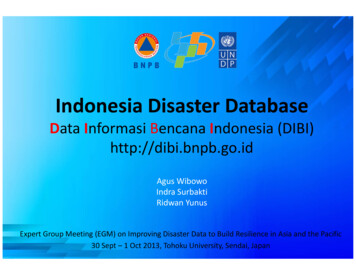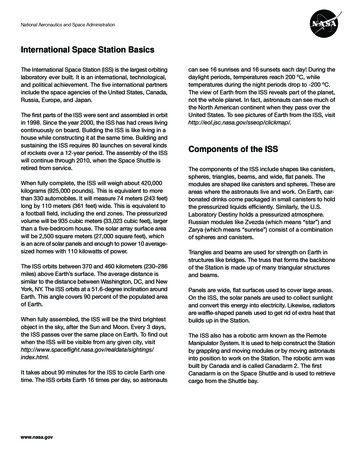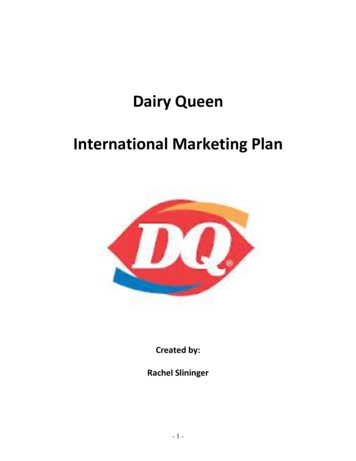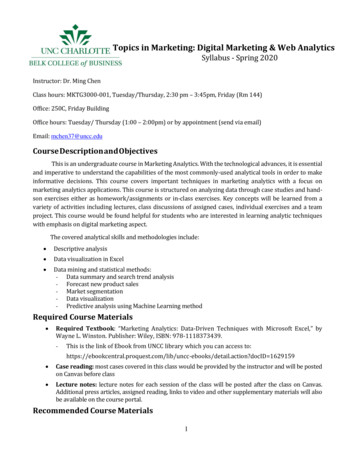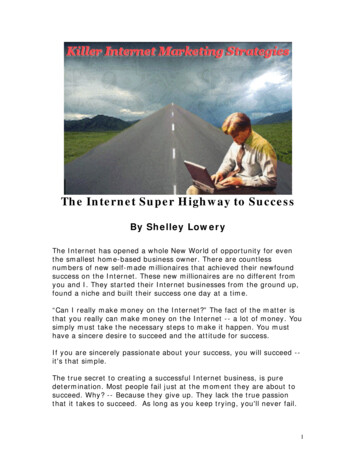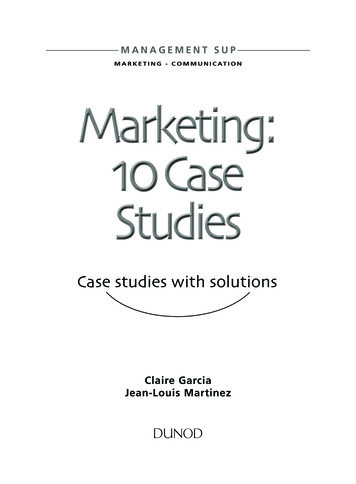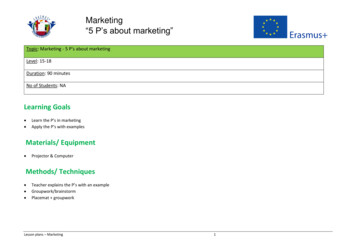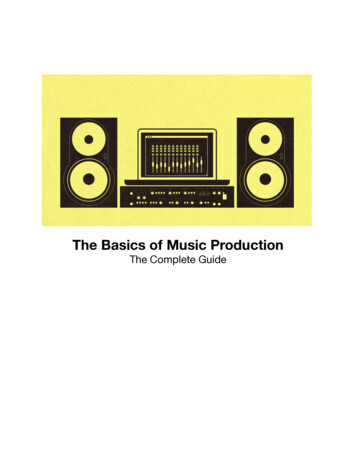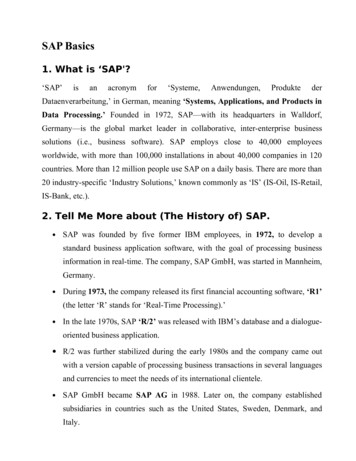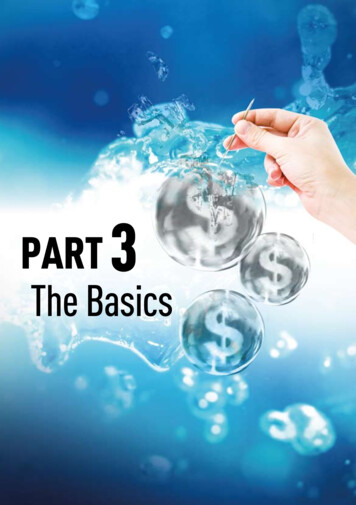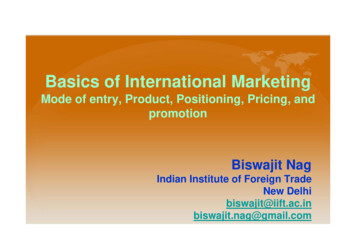
Transcription
Basics of International MarketingMode of entry, Product, Positioning, Pricing, andpromotionBiswajit NagIndian Institute of Foreign TradeNew Delhibiswajit@iift.ac.inbiswajit.nag@gmail.com
Steps for ExportsCommitment to ExportAnalyseExternal FactorsInternal FactorsDecide on-Product-Market Environment-Competitive Profile-ResourcesInternational Market InvolvementMarket SelectionMarket EntryMarketing Mix*Product *Price *Distribution *PromotionSet TargetsImplementOrganiseDepartmentSubsidiaryJt. VentureExport HouseExportReviewModifySet new targetAllocate Resources*Product*Arrange Resources
International Marketing/Distribution ChannelPRODUCERMerchantImporterDistributorHome MarketMiddlemenAgentAgent / BrokerWholesalerForeign MarketMiddlemenRetailerRetailerConsumer / Institutional User
Market EntryExport EntryContractual EntryInvestment Entry-AssemblyIndirectDirect-Contract Manufacturing-LicensingExport HousesAgents-Franchising-Co-production agreement-Management contractCommission AgentExporters Agent AbroadJoint VentureMajorMinorWholly Owned Subsidiary50:50AcquisitionEstablishing own unit
Schematic Model
Market Entry Mode and Risk
Which strategy should be used?It depends on: Vision Attitude toward risk How much investment capital is available How much control is desired
LicensingA contractual agreement whereby one company (thelicensor) makes an asset available to another company(the licensee) in exchange for royalties, license fees, orsome other form of compensationPatentTrade secretBrand nameProduct formulations
Licensing vs FranchisingThe primary difference between a franchisee and a licensee is that franchiseescan expect to have a much closer relationship with their parent company thantheir licensee counterparts. Franchisees typically retain rights to the parentcompany’s trademark and logo. This is important because it is a visiblerepresentation of the connection between franchisor and franchisee.The relationship between licensees and the licensing company is looser than therelationship between franchisors and franchisees. In most cases, the licenseedoes not retain rights to use the company’s trademark. Instead, the licensee isexpected to establish its own identity in the marketplace.License opportunities are often less expensive than franchises in both theupfront investment and ongoing fees. Once the licensee launches the operation,the relationship with the licensing company is frequently limited to purchasingproducts whereas franchisees can expect to pay royalties on a go-forward basis.
Franchise
Franchising Questions Will local consumers buy your product? How tough is the local competition? Does the government respect trademark and franchiserrights? Can your profits be easily repatriated? Can you buy all the supplies you need locally? Is commercial space available and are rents affordable? Are your local partners financially sound and do theyunderstand the basics of franchising?
Investment Partial or full ownership of operationsoutside of home country– Foreign Direct Investment Forms– Joint ventures– Minority or majority equity stakes– Outright acquisition
Joint Ventures Entry strategy for a single target country inwhich the partners share ownership of anewly-created business entity
How to Choose a Strategy? Two errors that management makes inchoosing a strategy– NIH (Not invented here) syndrome meansmanagers ignore the advancements ofsubsidiaries overseas– Managers impose policies upon subsidiariesbecause they assume what is right forcustomers in one market is right in everymarket10-14
How to Choose a Strategy? Cave Dweller – new products launchedinternationally to dispose of excessproduction Naïve Nationalist – company recognizesgrowth opportunities outside of homemarket Globally sensitive – company views worldas competitive marketplace10-15
How to Choose a Strategy? The product itself, defined in terms of thefunction or need it serves The market, defined in terms of theconditions under which the product isused, preferences of potential customers,and ability to buy the product Adaptation and manufacturing costs thecompany will incur10-16
Basic Product Concepts A product is a good, service, or idea– Tangible Attributes– Intangible Attributes Product classification– Consumer goods– Industrial goods10-17
Product Types Buyer orientation– Amount of effort expended on purchase– Convenience– Preference– Shopping– Specialty10-18
Country of Origin as Brand Element Perceptions about and attitudes towardparticular countries often extend toproducts and brands known to originate inthose countries– Japan– Germany– France– Italy10-19
Extend, Adapt, Create: StrategicAlternatives in Global Marketing Extension – offering product virtuallyunchanged in markets outside of homecountry Adaptation – changing elements of design,function, and packaging according toneeds of different country markets Creation – developing new products forthe world market10-20
Global Product Planning: rentSameStrategy 2:Product ExtensionCommunicationAdaptationStrategy 1:Dual ExtensionDifferentStrategy 4:Dual AdaptationStrategy 3:Product AdaptationCommunicationExtension10-21
Product Decision
Companion Products Products whose sale isdependent upon the saleof primary product– Video games aredependent upon the sale ofthe game Console “If you make money onthe blades you can giveaway the razors.”X-Box Game System and Sports Game11-30
Pricing Decision
Basic Pricing Concepts The Global Manager must developsystems and policies that address– Price Floors– Price Ceilings– Optimum Prices Must be consistent with globalopportunities and constraints11-32
Global Pricing Objectives andStrategies Managers must determine the objectives for thepricing objectives– Unit Sales– Market Share– Return on investment They must then develop strategies to achievethose objectives– Penetration Pricing– Market Skimming11-33
Market Skimming Market Skimming– Charging a premiumprice– May occur at theintroduction stage ofproduct life cycle11-34
Penetration Pricing Penetration Pricing– Charging a low price inorder to penetratemarket quickly– Appropriate to saturatemarket prior toimitation bycompetitors11-35
Right Price An important determinant of business success. Right price does not always mean low price. Right price depends upon factors like nature of the market, costs,competition, buyers purchasing power, foreign exchange fluctuations etc. Sometimes companies price the product very low with certain specificobjectives like market penetration, using price as a strategic marketingvariable to achieve the firm’s objective. Japanese firms in general aim atbuilding market share rather than early profits. Sometimes low price is the result of predatory pricing strategy. This is apractice of temporarily selling at prices below cost with the intension ofdriving out existing competitors or warding off new competitors.Pricing Approaches Major pricing approaches are Cost – based pricing and Market – basedpricing.
Cost-based pricing Cost based pricing, also known as cost plus pricing, is a common method of pricing.Under this method the price includes a certain percentage of profit margin on the sumtotal of the full cost of production, marketing costs an allocation of the overheads. Thatis Price [fixed cost variable costs overheads marketing costs] specifiedpercentage of the total cost.Market-based pricing When exporters are price followers rather than price setters. Involves assessment of prevailing prices in International Markets and a top-downcalculation is made. This is very flexible policy in the sense that is allows the prices to be changed inaccordance with the changes in the market conditions. The product may be priced highwhen demand conditions are very good and the price may be lowered when the marketis sluggish if that helps in increasing sales. This method is sometimes referred to aswhat the traffic will bear method,ie., charging the maximum possible price given themarket conditions.
Following Competitors Many firms follow the dominant competitors, particularly the price leader, insetting the price. The price leader is the firm which initiates the price trends.Negotiated Prices Deciding the price by negotiations between the seller and the buyer. This is popularwith government and institutional purchases.Customer Determined Price In a number of cases, the foreign buyer specifies the price at which he is preparedto buy the product. Whether a price quotation given by the buyer will be acceptableto seller or not will depend on factors like his cost structure, conditions of business,objectives etc.Marginal Cost Pricing Marginal cost pricing approach is common in evaluating the profitability of ordersin case of firms with excess (ie., idle) capacity. Under the marginal cost pricing, the relevant cost considered for pricing is thevariable cost, the fixed cost is excluded from the calculation of the cost of theproduct.
Positioning Locating a brand in consumers’ mindsover and against competitors in terms ofattributes and benefits that the brand doesand does not offer– Attribute or Benefit– Quality and Price– Use or User– Competition
Positioning Strategies Global consumer culture positioning– Identifies the brand as a symbol of a particularglobal culture or segment Foreign consumer culture positioning– Associates the brand’s users, use occasions,or product origins with a foreign country orculture
Positioning Strategies
International Channel Strategies Two forms of channel strategy– direct involvementOwn sales force, retail stores, etc.– indirect ers
Characteristics Impacting on ChannelDesign and Strategy I Customer characteristics– customer number, geographicdistribution, income, shopping habits,reactions to different selling methods– Need for multiple channels increases asthe number of customers increased Product characteristics– perishability, service requirements, bulk
Characteristics Impacting onChannel Design and Strategy II Middleman characteristics– attitude towards the manufacturer selection & care of distributors &agents distributor & agent performance termination Environmental characteristics– economic, social & political dimensions
Distribution Channels for ConsumerProducts Door-to-doorManufacturer-owned storeFranchise operationsCombined structures
Promotion through MarketingCommunication Marketing communications includesadvertising, public relations, personalselling, sales promotion, direct marketing,trade shows and sponsorship Either local adaptation or distinct localcampaigns may be required48
Promotion Strategy
Promotion Mix
Promotion Regulation: Examples
Cost based pricing, also known as cost plus pricing, is a common method of pricing. Under this method the price includes a certain percentage of profit margin on the sum total of the full cost of production, marketing costs an allocation of the overheads. That is Price [fixed cost variable costs overheads marketing costs] specified
